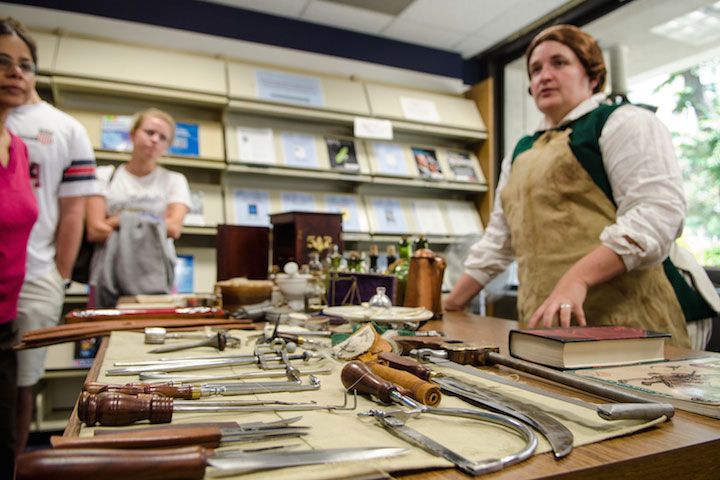
Death came in many forms and with alarming frequency for American soldiers during the Revolutionary War. Musket balls, cannon fire, bayonets and freezing winter temperatures made life dangerous for members of George Washington’s Continental Army.
The most lethal threat, however, was a silent one. Of the 25,000 American soldiers who died during the war, around 65 percent succumbed to disease, according to Denver Brunsman, assistant professor of history.
“This was one of the biggest hurdles that armies faced,” Dr. Brunsman said Monday at the opening of a new National Library of Medicine traveling exhibit on Revolutionary War-era medicine at the School of Medicine and Health Sciences’ Himmelfarb Library. “Although there was some knowledge about germ theory, it wasn’t widely known or accepted. The American armies of the time made all different kinds of mistakes, improperly quarantining sick soldiers and placing latrines in bad spots where germs could contaminate food and living quarters.”
The military wasn’t alone. Early Americans hadn’t advanced in their knowledge of medicine much past what the ancient Greeks and Romans knew, Dr. Brunsman said. They still followed the theory of humors—that there are four essential fluids in the body: blood, phlegm, black bile and yellow bile—and their methods for treating disease were primitive.
“Amputation was the best thing they had a grasp on,” said Mea Clift, a historical re-enactor who displayed and explained surgical instruments from the 18th century during Monday’s exhibit opening. “Most of the medicinal methods were from apothecaries. The primary goal was to get it out, whatever ‘it’ was—make you cough, make you bleed, make you throw up.”
The exhibit, “Every Necessary Care & Attention: George Washington & Medicine,” will remain at GW until the end of July. It includes images and documents exploring Washington’s health and examining ways in which he sought to safeguard the health and wellness of his family, staff, slaves and troops.
Washington, as an educated man, was ahead of the curve in a few ways regarding medicine.
“The founding fathers had knowledge of more than one field, which was unusual,” said Columbian College of Arts and Sciences senior Tareq Hamdan, a biology major and history minor who attended the event. “Washington was a general, but he also ran a house of more than 300 people and he was, for all intents and purposes, the primary health care provider.”
Washington insisted on clean camps—“An advancement of the time that likely saved lives during the war,” Dr. Brunsman said—and he understood the basic needs of his soldiers, especially regarding cleanliness and the importance of maintaining supply lines.
“Though the germ theory of disease was still in the future, Washington was aware of the linkage between better hygiene and nutrition and improved health,” said W. Scott Schroth, M.D., associate dean for administration and associate professor of medicine in the School of Medicine and Health Sciences. “To the extent that he was able, he tried to support these efforts for his troops.”
His shrewd decision to inoculate American soldiers from smallpox was an example of that knowledge, Dr. Brunsman said. In the 1770s, smallpox, a common childhood disease in Europe, wasn’t as widespread in the colonies and was both deadly and highly contagious in American camps. The method of inoculating people against smallpox—by taking samples of the disease from pustules of victims and putting it into healthy people—was one of the most intensely debated medical issues of the Colonial era.
Washington, who contracted smallpox in 1751 while on a journey to Barbados and understood the disease firsthand, began inoculating the Continental Army in 1777, methodically infecting, quarantining and treating soldiers for the proper amount of time so they would build up immunity without spreading the disease.
“This removes smallpox as a factor for the rest of the war,” Dr. Brunsman said. “I think it’s another example of the scientific side of Washington benefitting his soldiers. He was really at the forefront of knowledge at the time about medicine.”
For more photos, see GW Today's coverage.


